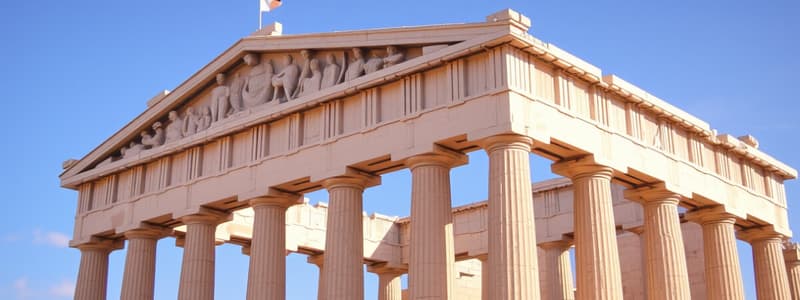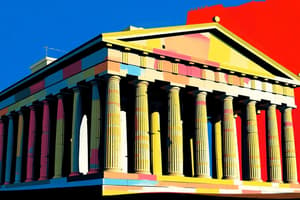Podcast
Questions and Answers
What is the dedication of the Parthenon to?
What is the dedication of the Parthenon to?
- Zeus
- Apollo
- Athens
- Athena Parthenos (correct)
Who are the chief architects of the Parthenon?
Who are the chief architects of the Parthenon?
Iktinos and Kalikrates
What represents the change from the archaic style in Athens?
What represents the change from the archaic style in Athens?
Classical style
What does Post-Lintel Architecture refer to?
What does Post-Lintel Architecture refer to?
How did Xerxes' army impact the Parthenon?
How did Xerxes' army impact the Parthenon?
Who ushered in the Golden Age of Greece by rebuilding Athens?
Who ushered in the Golden Age of Greece by rebuilding Athens?
What does the Parthenon symbolize for Pericles?
What does the Parthenon symbolize for Pericles?
Who created the sculpture of Athena in the Parthenon?
Who created the sculpture of Athena in the Parthenon?
What was the strategic design reason for the entrance placement of the Parthenon?
What was the strategic design reason for the entrance placement of the Parthenon?
What design refinements were made in the structure of the Parthenon?
What design refinements were made in the structure of the Parthenon?
What distinguishes high relief sculptures from low relief sculptures?
What distinguishes high relief sculptures from low relief sculptures?
What is stored in the Treasury Room of the Parthenon?
What is stored in the Treasury Room of the Parthenon?
Flashcards are hidden until you start studying
Study Notes
Dedication
- The Parthenon is dedicated to Athena Parthenos, central to the Acropolis in Athens, symbolizing its significance to the city's identity.
Architects
- Iktinos and Kalikrates served as chief architects of the Parthenon, constructed between 447 and 438 B.C., with decorations finalized by 432 B.C.
- Phidias, the master builder, is credited for all sculptures in the Parthenon.
Classical Style
- The Parthenon marks a transition from archaic to classical style, reflecting Athens' rise as a dominant city-state in the 5th century B.C.
- It embodies themes of power and authority, emphasizing a harmonious relationship with nature.
Post-Lintel Architecture
- The Parthenon features 17 columns along the long side and 8 on the short side, supporting a simple yet meaningful entablature and triangular pediment.
Acropolis Fortress
- The ruins of the Parthenon II, destroyed by Xerxes' army, were repurposed as part of the Acropolis fortress, symbolizing resilience and sacrifice.
Pericles
- Pericles (492-429 B.C.) was instrumental in Athens' Golden Age, leading the rebuilding of the city and commissioning the Parthenon through democratic approval.
Symbolism
- Pericles viewed the Parthenon as a testament to ancestral heritage, capturing Athens' greatness and democratic ideals.
- It serves as a symbol of individual contributions to the greater good, reflecting the aspirations of Athenian citizens and later influencing American architecture.
Sculpture of Athena
- The Parthenon hosts a statue of Athena, designed for direct interaction with the divine rather than typical worship settings.
- Sculptor Phidias created a monumental Athena that dominates the temple's center, portraying her as a militaristic goddess.
Placement of Entrance
- The entrance is positioned at the far short side, designed to showcase the Parthenon's beauty to passersby, emphasizing its divine and societal significance.
Size Refinements
- The Parthenon incorporates various architectural refinements such as column curvature, inclination, and thicker corner columns, creating an illusion of grandeur.
- Each of the 70,000 individual pieces exhibits unique characteristics, enriching the visual experience.
High Relief
- High relief sculptures like the metopes appear to emerge from their stone background, showcasing intricate carvings that enhance the scene's depth.
Low Relief
- Low relief sculptures, such as those on the frieze, are less detached from their stone surfaces, resulting in a more subtle representation.
Treasury Room
- A dedicated treasury room within the Parthenon served to store wealth and spoils, contributing to the civic pride of Athens' citizens.
Studying That Suits You
Use AI to generate personalized quizzes and flashcards to suit your learning preferences.




